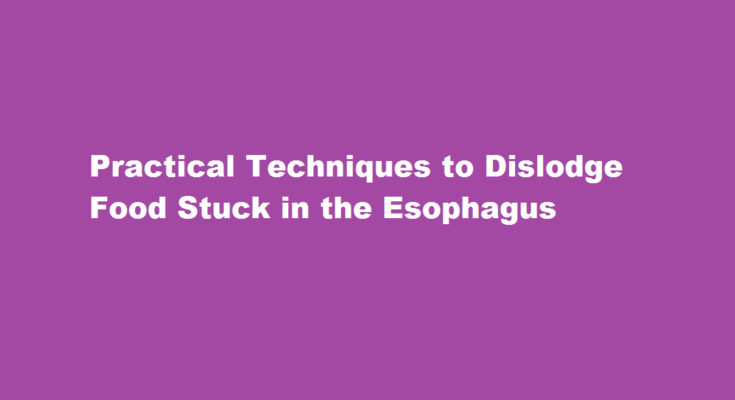Introduction
Food getting stuck in the esophagus can be a distressing and potentially dangerous situation. It may cause discomfort, pain, and difficulty swallowing. In this article, we will explore practical techniques to dislodge food effectively and safely from the esophagus, ensuring prompt relief and preventing complications.
Understanding the Esophagus
The esophagus is a muscular tube connecting the throat to the stomach, responsible for transporting food and liquids during swallowing. Sometimes, due to various factors such as underlying medical conditions, inadequate chewing, or eating too quickly, food may become lodged in the esophagus. If not addressed promptly, this can lead to complications such as infections, blockages, or damage to the esophageal lining. It is crucial to take immediate action when food becomes stuck to avoid potential risks.
Stay Calm and Assess Symptoms
If you feel food is stuck in your esophagus, it is essential to remain calm and avoid panicking. Assess your symptoms carefully. Common signs include a feeling of fullness in the chest, pain or discomfort while swallowing, regurgitation, or the sensation of food getting stuck. If you experience severe pain, difficulty breathing, or have been unsuccessful in previous attempts to dislodge the food, seek immediate medical attention.
Drink Fluids
In many cases, drinking fluids can help dislodge the food obstructing the esophagus. Take small sips of water or any other non-alcoholic, non-carbonated beverage. The liquid helps lubricate the esophagus, facilitating the movement of the stuck food. Avoid large gulps, as this may worsen the situation or cause choking. If water alone doesn’t work, you may try warm liquids or small amounts of olive oil, which can help soften the food and ease its passage.
Gentle Swallowing Maneuvers
Engaging in specific swallowing maneuvers can aid in dislodging the food. One technique involves taking a deep breath and swallowing hard to create increased pressure in the esophagus, potentially pushing the food down. Another method is to lean forward while swallowing, as the gravity assists in moving the food along. It is crucial to perform these maneuvers carefully and avoid excessive force, as it may cause injury or further blockage. Remember to remain calm and patient, as it might take a few attempts before the food becomes dislodged.
Encourage Coughing
Coughing forcefully can sometimes help expel the obstructing food. Lean forward slightly and cough vigorously to generate enough pressure to dislodge the stuck food. This method is not recommended for individuals with a weak cough or those experiencing severe pain, as it may exacerbate their condition. If coughing proves ineffective or worsens the symptoms, seek immediate medical attention.
FREQUENTLY ASKED QUESTIONS
What are symptoms of food stuck in the esophagus?
Chest pain, the feeling of food stuck in the throat, or heaviness or pressure in the neck or upper or lower chest may be present. Other symptoms may include: Cough or wheezing that becomes worse. Coughing up food that has not been digested.
How long can something be stuck in your esophagus?
Sometimes after you swallow a pill it may feel like it “got stuck” or didn’t go all the way down. This feeling usually goes away within 30 to 60 minutes if you drink liquids or eat a piece of bread. You may not have any symptoms when something is stuck in your esophagus.
Can xray show food stuck in the throat?
Radiographic evaluation is useful to detect any associated complications, such as free mediastinal air from perforation; however, food boluses, including fish or chicken bones, are radiolucent and not readily visualized on plain radiographs.
Conclusion
When food becomes stuck in the esophagus, prompt action is crucial to ensure safety and relieve discomfort. By staying calm, assessing symptoms, drinking fluids, and employing gentle swallowing maneuvers or coughing techniques, it is often possible to dislodge the food successfully. However, if these methods fail or if you experience severe symptoms, it is essential to seek medical assistance promptly. Remember, prevention is better than cure, so practice mindful eating and chew food thoroughly to minimize the risk of food getting stuck in the esophagus.
Read Also : Time Travel Unlocking the Secrets of Temporal Journeys



